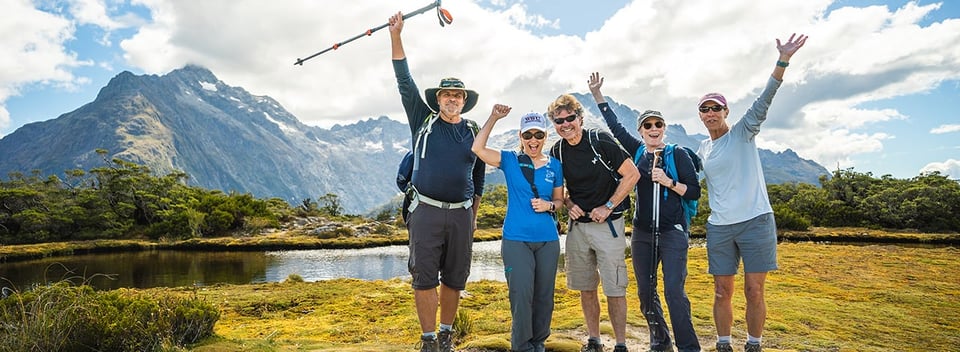
When is the Best Time to Visit New Zealand?

Any time during our hiking season which runs from October through to April is a great time to visit New Zealand. Our climate is lovely and temperate, with the highest temperatures in these months only reaching around the mid 20s C or high 70s F - the perfect temperature for getting outside and exploring.
New Zealand’s unique climate
As an island nation with a temperate maritime climate, we’re rarely impacted by extreme weather conditions. However, if you’re a hiker or enjoy getting out into nature’s playground, then you’ll find certain times of year are more favourable for outdoor pursuits. Check out our guide on hiking in New Zealand if you're looking for the ultimate outdoor adventure guide.
As we’re in the Southern Hemisphere, our seasons are the opposite way around from the Northern Hemisphere. Our hiking season runs from spring (October) through to autumn (April) with peak summer landing between December and February. Winter is from June through August. While winter is comparatively mild compared to other places in the world, mountain snowfall and icy conditions (especially on the South Island) can mean many walks and hikes are off-limit over the winter months.

It's a tough job picking the best time to visit New Zealand; every season has significant advantages, so pick one that suits you best!
New Zealand Trails hiking season - when is the best time to visit New Zealand?
We want our guests to enjoy all that New Zealand’s beautiful landscape has to offer, so we run our trips between October and April, avoiding the cooler months and more challenging weather conditions of winter. Travelling during these months allows our guests to explore a wide range of walks, hikes and experiences, as well as the best weather in New Zealand.
Locals tip: Most visitors and hikers choose to travel during the peak of summer but if you ask a local when is the best time to visit New Zealand, they'll tell you it's Spring or Autumn. It's the best time on the trails if you're looking to avoid the crowds and enjoy the most beautiful seasonal colours.
Here's a month-by-month breakdown of what to expect on your New Zealand adventure!
New Zealand weather in October
If you’re visiting New Zealand in October, then you’re in for a nice warm welcome. Spring in New Zealand means mild weather, bursts of vibrant colour as the wild lupins spring to life and calm, quiet trails - perfect for exploring!
October is mid-Spring for us with average temperatures sitting comfortably between in the early to mid 60's°F. You’ll also enjoy plenty of sunshine hours, perfect for hiking and experiencing the great outdoors.
Hiking weather in New Zealand in October
October officially marks the start of our hiking season and it’s a fantastic time of year to be out and about on the trails. With mild temperatures and the warm sun on your back, it’s very comfortable hiking weather. Spring is a fabulous time for hikers! As we mentioned, with many summer visitors yet to arrive, it’s a peaceful time to be out hiking and often you’ll get those pristine views all to yourself. There’s usually tiny dusting of snow on the mountaintops too, making our rugged peaks even more dramatic.
With lambs frolicking in the fields and the native birds warbling in the treetops, the trails might be quiet but our charming wildlife will keep you very well entertained on your travels during October!
New Zealand Trails travel tip for October: Our clocks ‘spring forward at the very end of September, so if you travel during October, you’ll enjoy longer days and lighter evenings, ideal for getting the most out of your day, as well as pre-dinner drinks on the deck as the sun goes down!

A gorgeous day in March on the Rocky Mountain Trail.
New Zealand weather in November
November is arguably one of the best months to visit New Zealand, with warm, dry conditions. Summer feels like it’s just around the corner. Most days will see the thermostat hitting at least 68 °F, often higher.
Hiking weather in New Zealand in November
Summer’s precursor, November is one of our favourite times of year for hiking. Despite the fantastic weather, it’s still a relatively quiet time of year out on the trails, so you’ll experience the best of both worlds as far as weather and visitor numbers go.
The New Zealand landscape is at its greenest and most vibrant during the spring months, so it’s a beautiful time of year to be hiking. Mount Cook lilies are flowering in alpine areas, while vast seas of purple and pink lupins are blanketing the valley floors. New Zealand fur seals are pupping and while it’s best to keep your distance, it’s a lovely sight to watch their playful antics from afar!
New Zealand Trails travel tip for November: November is the peak season for lupins and the Mackenzie Country on the South Island is one of the best places to visit if you’re hoping to see them in full bloom. It’s also an International Dark Sky Reserve, meaning the night sky here is particularly impressive.

Wild lupins spring to life, adding a burst of colour to Lake Tekapo's shores.
New Zealand weather in December
December marks the start of summer, as well as the holiday season for most Kiwis. The weather in New Zealand in December is great - temperatures are warm, skies are blue and as the nation gears up for the Christmas celebrations, there’s a feeling of festivity in the air. The longest day of the year falls in December and with the sun not setting until 10pm in parts of the country, you’ve got plenty of daylight hours to explore.
On your travels in December, you’ll likely see the Pohutukawa tree, also known as the “New Zealand Christmas Tree”. Commonly found in coastal regions on the North Island, its large crimson flower blooms in December. Along with beach BBQs and backyard cricket, the Pohutukawa is a Kiwi Christmas tradition!
Hiking weather in New Zealand in December
December is early summer, so temperatures are not quite at their highest, but you’ll often get days where the thermostat sits at or above 80 °F. New Zealand isn’t that humid, so despite the warmer weather, conditions are still very comfortable for hiking, especially if you’re by the sea (which much of New Zealand is!).
Lots of Kiwis take a break over the summer holiday period and use their time off to get out exploring their own backyard on overnight and day hikes. We’re a friendly bunch and chances are when you meet us out on the trails, we’ll be happy to have a chat and share some local hiking knowledge.
New Zealand Trails travel tip for December: If you’re a wildlife lover, December is a wonderful time of year to visit. Look out for groups of Little Blue penguins, as well as one of the world’s rarest, the Fiordland Crested penguin. Occasionally during the warmer months, you might also spot orca cruising through the bays enjoying their summer vacations too!

Our guests exploring Fiordland on a beautiful December day.
New Zealand weather in January
January is vacation time for most New Zealanders. Long, light days stretch out and the warmer temperatures make for perfect beach weather. Weather-wise, January and February are typically the warmest months of the year here in New Zealand with temperatures hovering between 23 and 28°C (73 – 82°F) up and down the country.
Hiking weather in New Zealand in January
The New Zealand weather in January is excellent and it’s a fantastic month for hiking! It’s mid-summer and temperatures can climb above the mid-80s, so it pays to pace yourself and drink plenty of water while you’re hiking. There’s usually an obliging stream or lake if you fancy a quick dip to cool off as well.
New Zealand Trails travel tip for January: It’s a popular time for visitors and locals alike to be out on the trails, so be sure to book your accommodation, transport and hikes (especially the Great Walks) well in advance.

January sunshine on Mou Waho Island.
New Zealand weather in February
February tends to be our warmest month and is perfect for enjoying water based activities like kayaking, boating, snorkelling and swimming. New Zealand is famous for its pristine waterways and you never need to travel far to find a lake, river or beach!
Hiking weather in New Zealand in February
February marks the end of the holidays in New Zealand, but it's still a very popular time with holidaymakers due to the warm conditions.
February is definitely a great time to hike in New Zealand, but there are also lots of other events and activities happening - outdoor festivals, concerts, sports events and races. Whether you’re taking part or just observing, it’s a fun time to visit and soak up the relaxed summer vibes.
New Zealand Trails travel tip for February: Pack a wide-brimmed hat to keep the sun at bay. Even better if it’s a quick-dry fabric - you can soak it in a stream and enjoy the cool breeze against your forehead as you walk!

Our guests on the Sealy Tarns Track, Aoraki/Mt Cook National Park, in February.
New Zealand weather in March
March is officially the start of autumn in New Zealand; however, it often feels more like an extension of summer with long, hot days and plenty of sunshine. The weather in New Zealand in March is usually mild and settled. The leaves are starting to change colour which makes for a very beautiful scene, especially in places like Arrowtown on the South Island, known for its spectacular autumn colours. March is the perfect time of year for those who want to make the most of the warmer temperatures and longer daylight hours of summer while avoiding the crowds and getting a good deal on flights.
Hiking weather in New Zealand in March
The New Zealand weather in March lends itself perfectly to hiking and walking. Over the autumn months, the New Zealand sky seems to turn impossibly blue and you’ll enjoy the stunning backdrop it provides to our scenery. March weather strikes the ideal balance between mild temperatures and settled conditions; what more could a hiker ask for?
New Zealand Trails Travel tip for March: With the grapes hanging ripe on the vines, March is a great time of year to visit some of our world-renowned wineries and sample the wines in a sun-soaked vineyard. March is also a bumper time of year for fresh local produce and seasonal delights – our farmers' markets are overflowing with tasty morsels to tempt your taste buds.

Two of our wonderful guests exploring Lake Matheson and the surrounding area in April.
New Zealand Weather in April
April is a beautiful time of year to visit New Zealand. The weather in New Zealand in April is known for its settled, sunny days, clear skies and cooler nights. As April rolls around the foliage starts to change colour, covering our hillsides in a fiery red and yellow blanket. The South Island is exceptionally glorious at this time of year, with places such as Wanaka and Queenstown ablaze with autumn colour.
Hiking weather in New Zealand in April
April is a brilliant time for hiking. The walking tracks are quiet, and the views are crystal-clear. With autumn colours in full force and little wind and rain, it’s the perfect time to stretch your legs on any one of our outstanding hiking trails. April enjoys long, fine spells making it the ideal time for overnight hikes in New Zealand’s glorious backcountry.
April also marks the end of the Great Walks season for several of New Zealand’s famous tracks, including the Milford Track, so it’s a good time to experience the hikes before winter sets in and they’re off-limits.
New Zealand Trails travel tip for April: May is the end of our hiking season at New Zealand Trails, so be sure to get your trip booked in before then. Airfares are often the lowest during the month of April and we can help you find flights and a good deal to fit in with your New Zealand Trails trip.

Want to find out more about our New Zealand hiking tours? Check out our various trip offerings and find the one that's right for you.







